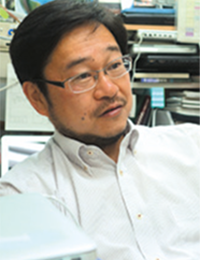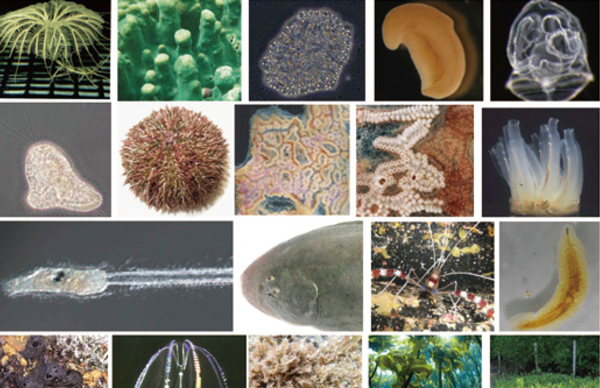他のメンバー : 吉田 正人 宮村 新一 今 孝悦 笹倉 靖徳 柴 小菊 柴田 大輔 出川 洋介 小林 悟 沼田 治 深水 昭吉 石田 健一郎 谷口 俊介 中山 剛 中野 裕昭 辻村 真貴 内海 真生 繁森 英幸 堀江 健生 木越 英夫 和田 洋 鈴木 健嗣
キーワード:海洋生物学、環境、生態、多様性、進化
 地球上の生命は約40 億年前に原始の海で誕生したと考えられています。それ以降、海はたえず生命の源として、また、生物の多様性を育む母体として機能してきました。「海洋生物学」リサーチユニットでは、海洋生物や海洋環境に関する基礎研究・学際研究をつうじ、ライフサイエンス、医学、水産学、環境科学など、生命が関わる多岐の学問についての知的基盤構築を目指しています。
地球上の生命は約40 億年前に原始の海で誕生したと考えられています。それ以降、海はたえず生命の源として、また、生物の多様性を育む母体として機能してきました。「海洋生物学」リサーチユニットでは、海洋生物や海洋環境に関する基礎研究・学際研究をつうじ、ライフサイエンス、医学、水産学、環境科学など、生命が関わる多岐の学問についての知的基盤構築を目指しています。
「海」というひとつの巨大な生態系をまるごと理解する
ヒトと海洋生物では全く異なる外見をもちますが、そのルーツをたどると約40 億年前に原始の海に誕生した生命に行きつきます。また、ヒトの体のイオン成分も海水に近いです。これは生命が海から生まれヒトへと進化してきた証です。たとえば、細胞分裂や受精など基本的な生命現象が初めて観察されたのはどちらも海の生物で、それらの知識がライフサイエンスの基盤となっています。一方で、海は物質循環や環境とも関係しています。たとえば、生活排水や海水酸性化などは海の生態系と切り離せない関係にあります。過去に海や海の生態系についての知識がないまま護岸工事などの開発を進めてしまった結果生じた環境破壊や環境汚染が問題になっていますが、これらの根本解決にもやはり海や海の生態系についての知識が必要になります(図1)。

図1:下田臨海実験センターで研究している海の生き物(一部)
下田臨海実験センターのフィールドを最大限に活用する
研究の対象は海の生物やそれらの生息環境が中心となりますが、下田臨海実験センターを利用している他の研究者との共同研究も進めています。具体的には①海洋生物のゲノム科学、ポストゲノム科学の推進、②海産生物の多様性を利用した細胞の構造・機能の解析、多様化機構の解明、③海産生物の発生過程、メカニズムの解明と生物系統発生、進化の考察、④免疫系、神経系、生殖系などの構築と成立メカニズムに関する研究、⑤海洋生物の個体間相互作用、個体群の形成、個体群相互作用と生態系の成立に関する研究、⑥海洋無機物・有機物の海洋生物生態に与える影響に関する研究、⑦地球環境変動と海洋環境に関する研究、⑧下田周辺の海洋フィールドに棲息する生物種の記述、⑨各種海洋生物の飼育繁殖に関する基礎研究、などを行っています。このユニットが本拠地にしている下田臨海実験センターのフィールドを最大限に活用した研究を実践することにより、ライフサイエンス、医学、水産学、環境科学など、多岐の学問の基盤となる研究、化学、物理、工学といった異分野との融合研究を目指しています(図2)。

図2:研究調査船「つくばⅡ」と下田臨海実験センター
社会への貢献・実績
- 市民講座、公開講座、一般公開、自然観察会、民間企業委託実験(付着生物検定)
- JAMBIO フォーラム・国際シンポジウムの開催、国際マリンステーション機構運営
取材:平成26年5月12日
Investigate the source of life “sea” to deeply understand “human beings”
Unit members : Yoshida Masahito Miyamura, Shinichi Kon, Koetsu Sasakura, Yasunori Shiba, Kogiku Shibata, Daisuke Degawa, Yosuke Kobayashi, Satoru Numata, Osamu Fukamizu, Akiyoshi ISHIDA, Ken-ichiro Yaguchi, Shunsuke Nakayama, Takeshi Nakano, Hiroaki Tsujimura, Maki Utsumi, Motoo Shigemori, Hideyuki Horie, Takeo Kigoshi, Hideo Wada, Hiroshi Suzuki, Kenji
Unit name: Marine Biology
Keywords: marine biology, environment, ecology, diversity, evolution
 Life on earth emerged in the ancient sea about 4 billion years ago. Since then, the sea has served as a source of life and nurtured biodiversity. Our research unit, “Marine Biology”, has attempted to construct an intellectual foundation for various biological sciences, such as life science, medicine, fisheries science, and environmental science through basic and interdisciplinary research on marine life and environment.
Life on earth emerged in the ancient sea about 4 billion years ago. Since then, the sea has served as a source of life and nurtured biodiversity. Our research unit, “Marine Biology”, has attempted to construct an intellectual foundation for various biological sciences, such as life science, medicine, fisheries science, and environmental science through basic and interdisciplinary research on marine life and environment.
Systematic understanding of the huge ecosystem “sea”
Human beings and marine lives are completely different in their appearances. However, both have a common root in the ancient sea about 4 billion years ago. The ion composition of the human body is similar to that of seawater, suggesting that life emerged in the sea and evolved into human beings. For example, basic life phenomena, such as cell division and fertilization, were first observed in marine organisms, providing information that has become the foundation of life sciences. On the other hand, the sea is associated with material circulation and environmental changes. For example, waste water and sea water acidification are closely related to marine ecosystems. Marine development, such as bank protection work, without consideration of marine ecosystems resulted in environmental destruction and pollution. Solving these problems require knowledge about the sea and marine ecosystems (Figure 1).

Figure 1: Examples of marine organisms being investigated at Shimoda Marine Research Center
Maximum utilization of Shimoda Marine Research Center
The major subjects of the study are sea creatures and their habitats. At the same time, we are promoting joint research with other researchers who are conducting research at Shimoda Marine Research Center. Specifically, we are engaged in (1) promotion of genome and post-genome sciences of marine organisms, (2) structural and functional analyses of cells based on the diversity of marine organisms and elucidation of diversification mechanisms, (3) research on developmental process and mechanisms of marine organisms and investigation of biological phylogeny and evolution, (4) investigation of construction and establishment mechanisms of immune, nervous, and reproductive systems, (5) research on interactions among individuals, establishment of populations, interactions among populations, and establishment of ecosystems of marine organisms, (6) evaluation of the effects of marine inorganic or organic substances on marine ecology, (7) research on global environmental changes and marine environment, (8) identification of marine organisms inhabiting the ocean around Shimoda, and (9) basic research on rearing and breeding of various marine organisms. Our research maximally utilizing the field of Shimoda Marine Research Center will provide an intellectual foundation for various sciences such as life science, medicine, fisheries science, and environmental science. We also aim for multidisciplinary research with other research fields including chemistry, physics, and engineering (Figure 2).

Figure 2: Research ship “Tsukuba II” and Shimoda Marine Research Center
Social contributions and achievements
- Open lecture, public lecture, open house, nature observation, experiments sponsored by private companies (adhesion bioassay)
- JAMBIO forum, international symposium, international marine station
Interviewed on May 12, 2014
